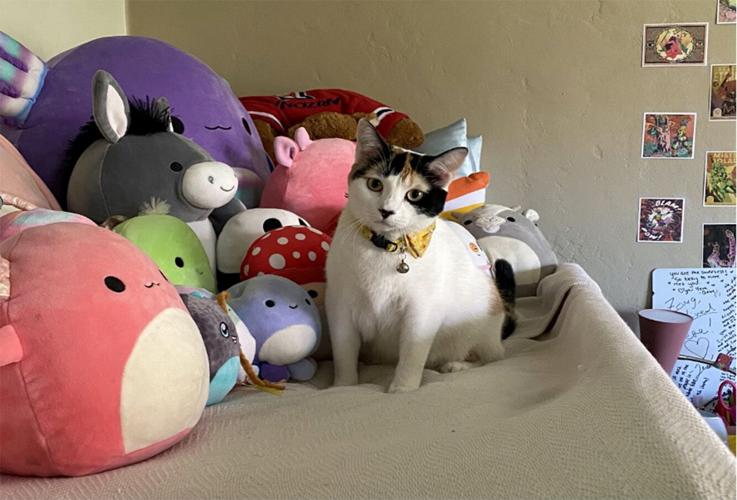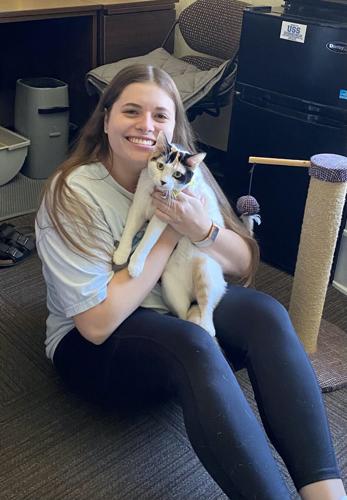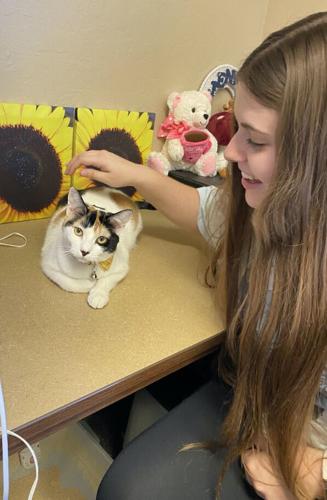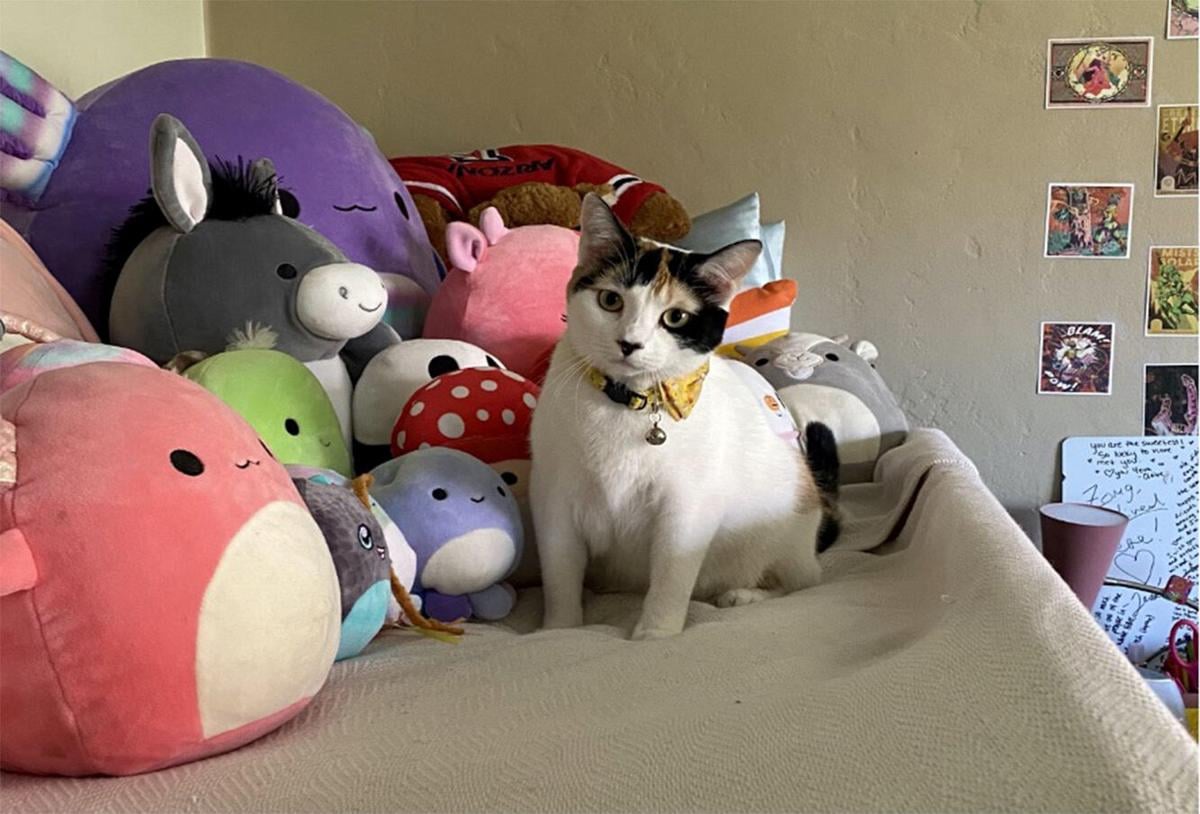Almost every morning when Jennalee Wilson wakes up, she is forced out of bed by her furry alarm clock, Cleo the calico cat.
“I cannot get out of bed, it’s the biggest challenge of the day, but little Cleo will be sitting, and her bowl will be full, let me just state that,” Wilson said. “But she will still be sitting by the food bowl and meow until I get up and put a little more food in for her or play with her.”
Wilson, 22, is a senior at the University of Arizona double majoring in Family Studies and Human Development Care, Health, and Society. Wilson has been diagnosed with depression and anxiety.
Over the summer of 2021 she adopted Cleo in hopes of helping her cope. Wilson was able to get approval from the university’s Disability Resource Center allowing Cleo to live with her in the dorms as an emotional support animal.
The number of emotional support animals living in University of Arizona student housing increased from 17 in 2019 to 58 currently. During 2021 there was an all-time high of 73 animals, at the peak of the COVID-19 pandemic.
“When the campus was closed and there were not as many social gatherings or opportunities to meet people on campus a lot of students were feeling isolated or struggling with their mental health and were looking for companionship,” said Taylor Thornby who is an access consultant at the Disability Resource Center.
Of the 58 emotional support animals living in residence halls, cats comprise 26, dogs 16, and 16 are a variety of other animals. Of the non-cat-dog variety, “most of the time we are getting smaller mammals like bunnies or hamsters, but we do get some reptiles and other animals like that,” Thornby said.
The process of getting a pet approved at the University of Arizona begins by contacting the Disability Resource Center to get a form to fill out, including information to be provided by a mental health specialist.
Once the center has all the required paperwork they conduct an interview over Zoom, asking questions about why they feel they need an emotional support animal and about the animal’s behavior.
“Typically, we would say ‘no’ if the animal has shown aggression … once we are talking with them and they say that the animal has bit somebody or maybe if they weren’t fully house trained,” Thornby said.
Other reasons an animal will be rejected is if it is not up to date on vaccinations, if it is too large for the space, if their roommate has serious allergies or if it causes excessive property damage.
Animals approved for the classroom have not had any significant increase or decrease during the pandemic, typically hovering between nine and 14 animals at any one time.

Jennalee Wilson, a University of Arizona student living in on-campus housing, with her cat Cleo.
The process for classroom approval is similar. Approval depends on the class setting, for example an animal would likely not be approved for a chemistry lab due to the danger of chemicals and materials being used.
Once approved, professors can only keep animals from the classroom if they go through the Disability Resource Center first. Thornby describes it as a collaborative effort where the center, the professor and the student try to come to a solution before banning the animal.
Wilson described the process of getting Cleo approved for her dorm as quick and easy. It took about a month. The process was longer partly due to Wilson being out of town for two weeks.
Scientists, including those at the UA, are discovering the mental health benefits of pets.
The Canine Cognition Center is a group at the University of Arizona directed by Evan Maclean, a biological anthropologist and comparative psychologist.
They are currently working on a study regarding the correlation between oxytocin and cortisol levels in kids ages 8 to 10 when they interact with dogs.
Oxytocin is a hormone that is associated with feeling good and cortisol is a stress related hormone.
“Throughout these interactions we were taking saliva and urine samples and now we are actually analyzing the oxytocin levels and cortisol levels and working on trying to measure that,” said Elizabeth Carranza, who is one of three laboratory coordinators at the center.

Jennalee Wilson, a senior at the University of Arizona, has been diagnosed with depression and anxiety. Over the summer of 2021 she adopted her cat, Cleo, in hopes of helping her cope. Wilson was able to get approval from the university’s Disability Resource Center allowing Cleo to live with her in the dorms as an emotional support animal.
“We want oxytocin, which is that human bonding hormone, to kind of rise because it is good for them and it is good for the dog and we want to see cortisol which is a stress hormone to fall, if it does that speaks a lot to why you would want to argue the fact that it is good to grow up with a dog or it is good to have a dog around,” Carranza said.
“There is evidence for oxytocin and eye contact with dogs which is a paper that Evan is an author on and this idea that when we look and make eye contact with a dog our oxytocin levels actually rise,” she said.
It was also found that the dog’s oxytocin level also rises and has the same effect.
“They are these companion animals that are literally changing our hormone levels that are causing us to feel good and great and that is good for everybody,” Carranza said.
Cleo was 3 months old when Wilson adopted her and in that time she has helped Wilson at a low point in her life.
“The end of last year I went through a really bad breakup,” Wilson said. “I did not want to get out of bed, I did not want to do anything. My depression was at an all-time high, the anxiety was at an all-time high when I was at my lowest point. She was honestly my something to live for at the moment. My reason is to get out of bed, to feed her, to take care of her, to make sure she is happy and healthy.
“I think that if it wouldn’t have been for her, I would not have done anything. I wouldn’t have passed my classes, I probably wouldn’t have shown up for stuff, but she was really getting me out of bed and helping me start those days,” said Wilson, who is currently planning on attending graduate school to become a sex therapist.
Although Wilson thinks more people should be able to experience the support that a pet can bring, she understands that residence halls and pets are not always the greatest combinations. Since many of the pets go untrained and college students often go out a lot, pets are often left alone.
“I’m torn because I get it wouldn’t be logical to let every student have an untrained dog or cat or whatever they wanted, but at the same time, animals are so healing and so beneficial.”
Arizona Daily Star reporter, Cathalena Burch, and I are frequent walkers of Tumamoc Hill, located on the west side of Tucson. For the past several years we would come upon this family of deer eating and running across the walkway. On a recent morning they were not shy to hikers watching them and taking photos. Produced by: Mamta Popat, Arizona Daily Star







